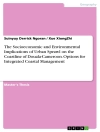This volume contains peer-reviewed papers from the Fourth World Landslide Forum organized by the International Consortium on Landslides (ICL), the Global Promotion Committee of the International Programme on Landslides (IPL), University of Ljubljana (UL) and Geological Survey of Slovenia in Ljubljana, Slovenia from May 29 to June 2, . The complete collection of papers from the Forum is published in five full-color volumes. This second volume contains the following:
• Two keynote lectures
• Landslide Field Recognition and Identification: Remote Sensing Techniques, Field Techniques
• Landslide Investigation: Field Investigations, Laboratory Testing
• Landslide Modeling: Landslide Mechanics, Simulation Models
• Landslide Hazard Risk Assessment and Prediction: Landslide Inventories and Susceptibility, Hazard Mapping Methods, Damage Potential
Prof. Matjaž Mikoš is the Forum Chair of the Fourth World Landslide Forum. He is the Vice President of International Consortium on Landslides and President of the Slovenian National Platform for Disaster Risk Reduction.
Prof. Binod Tiwari is the Coordinator of the Volume 2 of the Fourth World Landslide Forum. He is a Board member of the International Consortium on Landslides and an Executive Editor of the International Journal “Landslides”. He is the Chair-Elect of the Engineering Division of the US Council of Undergraduate Research, Award Committee Chair of the American Society of Civil Engineering, Geo-Institute’s Committee on Embankments, Slopes, and Dams Committee.
Prof. Yueping Yin is the President of the International Consortium on Landslides and the Chairman of the Committee of Geo-Hazards Prevention of China, and the Chief Geologist of Geo-Hazard Emergency Technology, Ministry of Land and Resources, P.R. China.
Prof. Kyoji Sassa is the Founding President of the International Consortium on Landslides (ICL). He is Executive Director of ICL and the Editor-in-Chief of International Journal“Landslides” since its foundation in 2004.
IPL (International Programme on Landslides) is a programme of the ICL. The programme is managed by the IPL Global Promotion Committee including ICL and ICL supporting organizations, UNESCO, WMO, FAO, UNISDR, UNU, ICSU, WFEO, IUGS and IUGG. The IPL contributes to the United Nations International Strategy for Disaster Reduction and the ISDR-ICL Sendai Partnerships 2015–2025.
表中的内容
Introduction: Landslide Field Recognition & Identification: Remote Sensing Techniques, Field Techniques.- Landslide Inventory Of Albania.- Multi-Sensor A Priori PSI Visibility Map For Nationwide Landslide Detection In Austria.- Determination Of The Landslide Slip Surface Using Electrical Resistivity Tomography (ERT) Technique.- Combining Spectral And Morphometric Properties Of Landslides For Separating Individual Landslides Based On Object-Oriented Method.- Sensor Data Integration For Landslide Monitoring – The LEMONADE Concept.- Landslide Diversity In The Rwenzori Mountains (Uganda).- Comparing Landslide Mapping From DTM Satellite Derived Data And Field Based Studies Of Loess Sediments In Western China.- Mechanism Of The Montescaglioso Landslide (Southern Italy) Inferred By Geological Survey And Remote Sensing.- Rock Fall Characterization In Climbing Spots: The Case Study Of The “Napoleonica” Tourist Route (Trieste, NE Italy).- Rock Avalanche Sedimentology – Recent Progress.- Landslide Monitoring At The Cala Rossa Sea Cliff (Favignana Island, Sicily).- Integration Of Multi-Sensor A-Dinsar Data For Landslide Inventory Update.- Spatiotemporal Landslide Mapper For Large Areas Using Optical Satellite Time Series Data.- Multitemporal UAV Survey For Mass Movement Detection And Monitoring.- Studying A Landslide In Its Paroxysmal Phase; The Reactivation Of The Sebrango Landslide (Spain), June 2013.- Mapping Rapid-Moving Landslide With Satellite SAR Images: The Case Of Montescaglioso (South Italy).- Combining Terrestrial And Waterborne Geophysical Surveys To Investigate The Internal Composition And Structure Of A Very Slow-Moving Landslide Near Ashcroft, British Columbia, Canada.- Using Lidar DEM To Map Landslides: Škofjeloško Cerkljansko Hills, Slovenia.- Using The Intensity Values From Terrestrial Laser Scanner (TLS) For Determining Lithology Of Flysch Rock Mass In Southwest Slovenia.- Multi-Temporal Landslide Evaluation By Using UAV: Some Insights On Disaster Risk In Teziutlán, Puebla México.- The Differential Slow Moving Dynamic Of A Complex Landslide: Multi-Senor Monitoring.- Erosion Processes And Mass Movements In Sinkholes Assessed By Terrestrial Structure From Motion Photogrammetry.- Method Of Estimating Slope Movement Area Using Dinsar Analysis.- Detection And Monitoring Of Slow Landslides Using Sentinel-1 Multi-Temporal Interferometry Products.- Summary Of Papers In Session 2 – Landslide Investigation: Field Investigations, Laboratory Testing.- A Case Study Of Deep-Seated Dukati Landslide, Vlore, Albania.- Integrated Geological-Geophysical Models Of Unstable Slopes In Seismic Areas.- Landslide Investigation Of A Residential Area In Göynüklü Village, Bursa (Turkey).- Pechgraben Landslide: Evaluation Of Geophysical/Geotechnical Methods In Terms Of Remediation Support.- Groundwater Flow Behavior At Landslide Area In Crystalline Schist Mountains.- Groundwater Flow Characterization Using Different Hydraulic Methods In A Large And Deep Earth Slide Rich In Clay.- Understanding Of Landslide Movement At Bumi Waluya Railway Station, Garut, Indonesia.- Stability Analysis Of Potential Rock Slides In El Rincón Cliff (GC-2 Highway, Gran Canaria, Spain).- H/V Technique For The Rapid Detection Of Landslide Slip Surface(S): Assessment Of The Optimized Measurements Spatial Distribution.- Applicability Of DIKW Model On Research Of Landslides.- THE APPPLICATION OF ERT FOR THE GEOMETRICAL ANALYSIS OF THE SEBRANGO LANDSLIDE, (CANTABRIAN RANGE, SPAIN).- Understanding Debris Flow Characteristics Using Flume Experiments.- Slope Stability Investigation Of Chandmari In Sikkim, Northeastern India.- High Performance Heterogeneous Data Storage System For High Frequency Sensor Data In A Landslide Laboratory.- Soil Characterization For Landslide Forecasting Models: A Case Study In The Northern Apennines (Central Italy).












